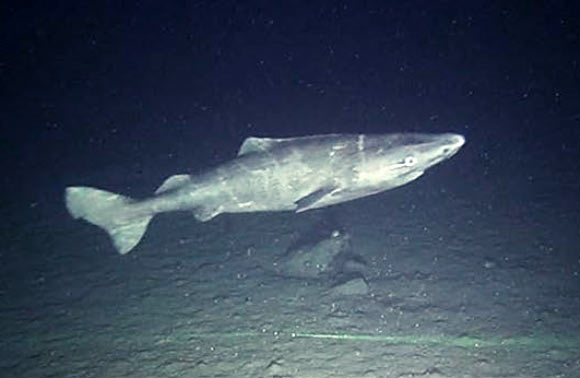A team of marine biologists from the Fisheries and Marine Institute of the Memorial University of Newfoundland has filmed Greenland sharks (Somniosus microcephalus) in their natural habitat in the waters of the Canadian Arctic Archipelago.

Juvenile Greenland shark (Somniosus microcephalus). Image credit: Devine et al, doi: 10.1038/s41598-017-19115-x.
One of very few polar shark species, the Greenland shark is found throughout the cold waters of the North Atlantic and Arctic Oceans.
It is the largest fish in the Arctic and is a top predator, despite being a slow swimmer and effectively blind, thanks to an eye parasite called Ommatokoia elongata.
However, the Greenland shark remains a poorly studied species and many aspects of its basic ecology are unknown.
Limited life history studies revealed a remarkably slow growth rate and late maturation timing. The species also holds the record for the longest lifespan of any vertebrate species.
“Greenland sharks appear to grow extremely slowly — less than one cm per year — and are believed to not reach maturity until females are 13 feet (4.5 m) long and males are 10 feet (3 m) long,” said team members Brynn Devine and Dr. Jonathan Fisher.
“They also have remarkable lifespans. Scientists recently used radiocarbon dating techniques on the eye lens of a Greenland shark, and found they can live for more than 272 years, making the species the longest living vertebrate on the planet.”
“While these are impressive traits, their age and large size leave Greenland sharks more vulnerable to stressors such as overfishing or habitat loss than other fishes.”
To collect information on sharks, the researchers deployed remote underwater video cameras in the northern Nunavut regions of Arctic Bay, Resolute, Lancaster Sound, Scott Inlet and Grise Fiord.
“After two summer field seasons (between July-September in 2015 and 2016), we had more than 250 hours of high-resolution video recorded from 31 locations,” they said.
“We used the video to distinguish one individual from the next based on their unique skin markings, a method researchers also use to identify for whale sharks and great white sharks.”
Greenland sharks appeared at 80% of deployments. Altogether, the team identified 142 individual sharks.
“The recordings gave us valuable insight into their abundance, size and behavior, as well as their distribution in the Canadian Arctic,” the scientists said.
“These findings are the first step towards closing a major knowledge gap on the population status of the Greenland shark.”
“And we did it without taking any sharks from the water.”
The research appears in the journal Scientific Reports.
_____
Brynn M. Devine et al. 2018. First estimates of Greenland shark (Somniosus microcephalus) local abundances in Arctic waters. Scientific Reports 8, article number: 974; doi: 10.1038/s41598-017-19115-x







